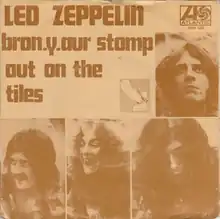Bron-Y-Aur Stomp
"Bron-Y-Aur Stomp" is a song recorded by English rock band Led Zeppelin for their third album, Led Zeppelin III, released in 1970.
| "Bron-Y-Aur Stomp" | |
|---|---|
 Netherlands single picture sleeve, 1970 | |
| Song by Led Zeppelin | |
| from the album Led Zeppelin III | |
| Released | 5 October 1970 |
| Recorded | 1970 |
| Studio | Headley Grange, England |
| Genre | |
| Length | 4:17 |
| Label | Atlantic |
| Songwriter(s) | |
| Producer(s) | Jimmy Page |
Background
The song is named after Bron-Yr-Aur, a house in Montgomeryshire, Wales, where the members of Led Zeppelin retreated in 1970 to write much of Led Zeppelin III after having completed a concert tour of North America.[4][5] Bron-Yr-Aur means "golden breast" or "breast of gold" in Welsh, as in a hillside of gold. Its pronunciation is [ˈbrɔn ər ˈaɪr]. The cottage had no electricity or running water, but the change of scenery provided inspiration for many of the songs on the album, including "Bron-Y-Aur Stomp".
Composition and recording
Jimmy Page and Robert Plant wrote "Bron-Y-Aur Stomp" in 1970. The song was heavily influenced by a number called "Waggoner's Lad" by Bert Jansch, a Scottish folk musician and founding member of the band Pentangle. It is a country music-inflected hoedown,[6] with lyrics about walking in the woods with Plant's blue-eyed Merle dog named Strider.[4] Plant reportedly named his dog after Aragorn (often called Strider) from J. R. R. Tolkien's The Lord of the Rings.[7] However, there are no explicit references to Tolkien works in "Bron-Y-Aur Stomp". In live performance, Robert often shouts "Strider!" at the end of the song.
The group recorded the song at Headley Grange in 1970, using the Rolling Stones Mobile Studio.[8] They completed it at Island Studios in London, and Ardent Studios in Memphis, Tennessee.[8] Guitarist Jimmy Page used an acoustic guitar, drummer John Bonham played spoons and castanets,[4] and bassist John Paul Jones played a double bass.[9]
Jennings Farm Blues
Led Zeppelin also recorded the song as an electric blues rock instrumental, "Jennings Farm Blues", a rough mix of which later surfaced as a studio out-take on a number of Led Zeppelin bootleg recordings.[4] Jennings Farm is the name of the property at Blakeshall on which the Plant family stayed in the early 1970s.[10] "Jennings Farm Blues" was released on 2 June 2014, as part of the remastering process of all nine albums.
See also
References
- Shadwick, Keith (2005). Led Zeppelin: The Story of a Band and Their Music 1968–1980 (1st ed.). San Francisco: Backbeat Books. p. 138. ISBN 0-87930-871-0.
- Grant Jackson, Andrew (20 July 2012). Still the Greatest: The Essential Songs of the Beatles' Solo Careers. Scarecrow Press. pp. 42–. ISBN 978-0-8108-8223-2.
- Davis, Stephen (2005). Hammer of the Gods. Pan Macmillan. p. 119. ISBN 978-0-330-43859-9.
- Lewis, Dave (1994). The Complete Guide to the Music of Led Zeppelin. Omnibus Press. ISBN 0-7119-3528-9.
- Sutcliffe, Phil (2003). "Back to Nature". Q. Special Led Zeppelin edition. p. 34.
- Led Zeppelin – III Platinum Bass Guitar: Authentic Bass TAB. Alfred Music. 2013. pp. 3–. ISBN 978-1-4706-2493-4.
- Drout, Michael D. C. (2007). J.R.R. Tolkien Encyclopedia: Scholarship and Critical Assessment. Taylor & Francis. pp. 540–. ISBN 978-0-415-96942-0.
- Lewis, Dave (2012). Led Zeppelin: From a Whisper to a Scream; The Complete Guide to the Music of Led Zeppelin. Omnibus Press. p. 38. ISBN 978-1-78038-547-1.
- Akkerman, Gregg (2014). Experiencing Led Zeppelin: A Listener's Companion. Lanham, Maryland: Rowman & Littlefield. p. 37. ISBN 978-0-8108-8916-3.
- Thompson, Dave (2014). Robert Plant: The Voice That Sailed the Zeppelin. Backbeat Books. pp. 94–. ISBN 978-1-61713-614-6.